
LinkedIn has become a vital tool for business networking, hiring, and enhancing brand visibility. But while you’re building professional connections and showcasing your company, cybercriminals are using the same platform to launch social engineering attacks, targeting businesses and individuals alike.
There has been a significant increase in LinkedIn-related threats impacting organizations of all sizes. Here’s what you need to know to stay protected.
What Is Social Engineering?
Social engineering is a form of manipulation where attackers trick individuals into revealing confidential information or granting access to sensitive systems. Unlike traditional cyberattacks that rely on technical vulnerabilities, social engineering exploits human psychology.
On LinkedIn, attackers use professional-looking profiles to build trust, pose as recruiters, vendors, or potential clients, and slowly extract valuable details about your business, systems, or employees.
Common LinkedIn Social Engineering Tactics
- Fake Recruiters or Job Offers
Cybercriminals pose as recruiters offering attractive job opportunities. These messages may contain malicious links or request personal information under the guise of scheduling interviews or verifying qualifications. - Impersonation of Colleagues or Executives
Attackers may create fake profiles mimicking executives or employees at your company. Once connected, they can gather intel or attempt to influence others within the organization. - Information Harvesting
Even without direct contact, attackers comb LinkedIn for organizational structure, technologies used, and employee roles—valuable information for planning phishing or spear-phishing campaigns. - Malicious File Sharing
A “connection” may send an attachment labeled as a proposal or resume that contains malware or leads to a credential-harvesting site.
Why This Matters to Your Business
When attackers use LinkedIn to gather intel, the consequences go beyond one compromised profile:
- Spear Phishing Emails Become More Convincing
Armed with job titles, work relationships, and company details, attackers craft highly targeted and believable phishing emails. - Business Email Compromise (BEC)
A well-planned social engineering campaign can lead to fraudulent wire transfers, leaked credentials, or unauthorized access to company systems. - Reputational Damage
If your company is used as a front for scams or your employees are targeted via LinkedIn, trust in your brand can suffer.
How to Protect Your Team on LinkedIn
- Educate Employees
Awareness is your first line of defense. Train staff to recognize red flags—unsolicited job offers, urgent messages from unknown accounts, or requests for sensitive information. - Encourage Secure Sharing
Remind employees not to overshare details about company tools, projects, or internal processes on public profiles. - Verify New Connections
Before accepting a connection or responding to messages, verify the person’s identity, especially if the interaction leads to file downloads or personal questions. - Implement a Zero Trust Approach
Assume no interaction is trustworthy until verified. Apply this mindset not just to emails but to all digital communication, including LinkedIn. - Monitor and Respond
Watch for impersonation attempts using your company name or logo. Report fake profiles and alert the affected users immediately.
Stay Ahead with Computek
Social engineering is evolving—and so should your defenses. At Computek, we help businesses across Georgetown and Central Texas build smarter cybersecurity strategies. From employee training to advanced threat monitoring and click time protection, we’ve got the tools and expertise to protect your business from attacks of all kinds. Even those starting with a simple LinkedIn connection.
Need help building your cyber defense plan?
Let’s talk. Contact Computek to schedule your free cybersecurity assessment today.
